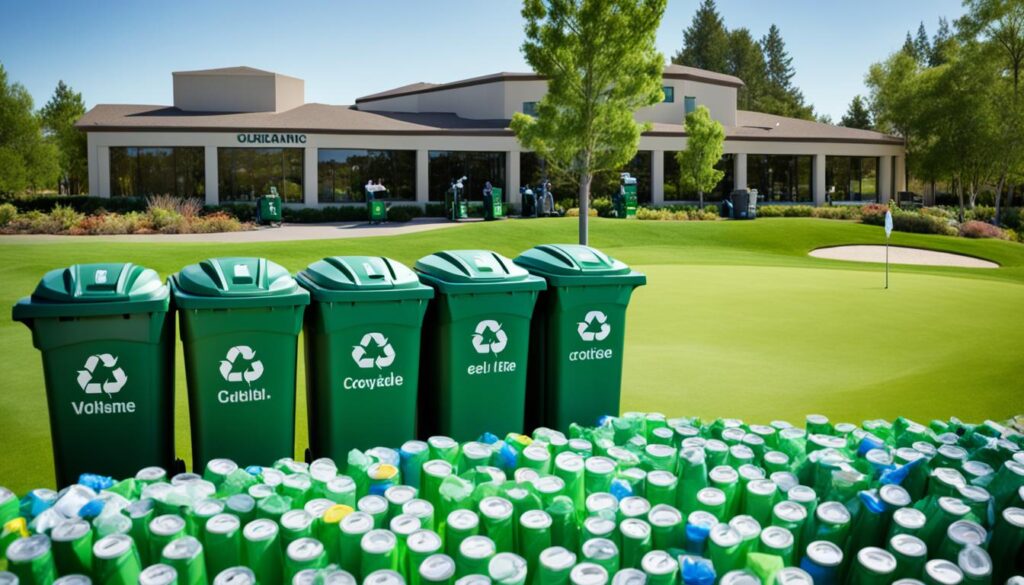Golf courses have the potential to have a significant impact on the environment if not managed properly. At [Golf Course Name], we are committed to implementing sustainable practices and environmentally friendly golf course management. Our goal is to minimize the negative effects of golf course maintenance and create a greener and healthier space for golfers and the local ecosystem.
In this article, we will explore a variety of eco-friendly golf course maintenance tips that promote sustainability and environmental conservation. From increasing biodiversity to reducing water usage, these practices can help us create a more eco-friendly golf course that both golfers and nature can enjoy.
Key Takeaways:
- Implementing sustainable golf course practices helps minimize the negative impact on the environment.
- Increasing biodiversity supports wildlife conservation and enhances the overall appeal of the golf course.
- Limiting pesticide use protects the health of golfers, wildlife, and the ecosystem.
- Reducing water usage through efficient irrigation and water recycling conserves valuable resources.
- Investing in better waste management, including recycling and composting, reduces environmental footprint.
Increase the Biodiversity of Your Golf Course
One important aspect of eco-friendly golf course maintenance is increasing the biodiversity of the course. By enhancing the natural habitat and promoting wildlife conservation, golf courses can create a thriving ecosystem that benefits both the environment and the golfing experience.
There are several ways to increase biodiversity on your golf course:
- Designate large natural spaces: Set aside areas of your golf course that are protected from human interference. These natural spaces can act as sanctuaries for wildlife, providing them with safe habitats to thrive.
- Add bodies of water: Incorporating ponds, lakes, or streams into your golf course design can provide essential water sources for birds, insects, and other wildlife. These aquatic habitats also attract diverse plant and animal species, contributing to the overall biodiversity of the course.
- Create densely wooded areas: Planting dense clusters of trees and shrubs throughout the course creates sheltered areas for wildlife. These wooded areas provide nesting sites, cover, and food sources, supporting a wide range of animals.
- Reduce mowed areas: Limiting the amount of turf grass that is regularly mowed allows natural vegetation to flourish. Native plants and wildflowers not only add beauty to the golf course but also provide food and shelter for various wildlife species.
By implementing these strategies, you can transform your golf course into a vibrant and sustainable ecosystem. Not only will this enhance the natural beauty of the course, but it can also attract golfers who appreciate and value environmental conservation.
Limit Your Use of Pesticides
When it comes to eco-friendly golf course maintenance, one of the most important tips is to limit the use of pesticides. Pesticides can have harmful effects on the environment, including polluting water sources and harming beneficial insects and wildlife. By reducing pesticide use, we can create a safer and healthier golfing experience for both golfers and the surrounding ecosystem.
Instead of relying heavily on conventional pesticides, consider incorporating organic alternatives into your pest management practices. Organic pesticides are made from natural ingredients and are designed to target specific pests while minimizing harm to non-target organisms.
One effective strategy is to use pest-resistant grasses in your course design. These grasses naturally deter pests, reducing the need for chemical treatments. Additionally, they often require less water and fertilizer, making them a sustainable choice for golf course maintenance.
Another alternative to consider is the use of boric acid or diatomaceous earth. These substances are naturally occurring and have insecticidal properties. They can be used to manage pests such as ants, termites, and crawling insects, without posing significant risks to human health or the environment.
| Pesticide Reduction Tips | Benefits |
|---|---|
| Implement integrated pest management (IPM) techniques | Reduces the need for pesticides by using a combination of preventive measures, monitoring, and targeted treatments. |
| Encourage natural predators | Attract beneficial insects and birds to the golf course, which can help control pest populations naturally. |
| Regularly monitor pest populations | By closely monitoring pest populations, you can intervene early and implement targeted treatments when necessary. |
| Improve turf and soil health | Healthy turf and soil can better resist pest infestations, reducing the need for pesticide applications. |
By reducing pesticide use and implementing organic alternatives, you can protect the health of golfers, promote biodiversity, and contribute to a more sustainable golf course ecosystem.

Reduce Water Usage
Water conservation plays a pivotal role in maintaining an eco-friendly golf course. By reducing water usage, we can minimize the impact on local water resources and contribute to a more sustainable environment. Here are some strategies that can help us achieve efficient water management:
- Utilize recycled water: Instead of relying solely on freshwater sources, we can explore the use of recycled water from treatment plants. This not only helps conserve water but also reduces reliance on potable water for irrigation.
- Implement rainwater harvesting systems: Installing rainwater harvesting systems allows us to collect and store rainwater for future use. This helps supplement the irrigation needs of the golf course during dry periods and reduces the demand for freshwater.
- Upgrade to efficient sprinkler heads: By investing in more efficient sprinkler heads, we can optimize water distribution and minimize wastage. Technologies such as drip irrigation and smart irrigation systems ensure targeted and precise watering, reducing water consumption and maximizing efficiency.
Implementing these water conservation measures not only lowers our environmental footprint but also has financial benefits. By reducing water usage, we can lower management costs associated with water consumption. Additionally, these efforts enhance the image of our golf course as a responsible steward of the environment.
“Water is a precious resource, and as stewards of the land, it is our responsibility to use it wisely. By adopting efficient irrigation practices and exploring water recycling options, we can contribute to the preservation of our environment while maintaining the beauty and playability of our golf course.”
Invest in Better Waste Management
Waste management plays a crucial role in creating an eco-friendly golf course. At our golf course, we prioritize implementing proper recycling practices, avoiding the use of non-recyclable materials like polystyrene, and working closely with our local municipality to find sustainable waste disposal methods. By improving waste management, we can significantly reduce our environmental impact and contribute to a greener future.
Recycling Practices
We believe in the power of waste recycling to minimize our ecological footprint. We have established designated recycling stations throughout the course, making it convenient for golfers and staff to dispose of recyclable materials properly. By recycling materials such as plastic bottles, aluminum cans, and paper products, we can reduce the amount of waste that ends up in landfills and promote a circular economy.
Composting for Sustainable Disposal
Composting is another key aspect of our waste management strategy. We have placed compost bins at strategic locations around the course, where green waste, such as grass clippings and leaves, can be collected and processed. The resulting compost is then used to enrich our green spaces and promote healthy plant growth. By diverting organic waste from landfills and utilizing it in an environmentally-friendly way, we reduce greenhouse gas emissions and close the nutrient loop.
“Composting allows us to turn waste into a valuable resource. By composting our organic waste, we create a natural fertilizer that nourishes our greens and fairways while reducing our environmental impact.”
– Golf Course Superintendent, Jane Smith
Partnering with the Local Municipality
We recognize the importance of collaboration in sustainable waste disposal. Our golf course works closely with the local municipality to explore innovative waste management solutions. Together, we explore options such as utilizing bio-digesters to convert food waste into energy, implementing recycling programs for hazardous materials like batteries and chemicals, and finding ways to further reduce waste generation in our operations. By partnering with experts, we can stay at the forefront of sustainable waste disposal practices in our community.

Investing in better waste management not only benefits the environment but also enhances our reputation as an eco-conscious golf course. By prioritizing waste recycling, composting, and collaborating with local authorities, we are dedicated to sustaining the beauty of the course while minimizing our environmental impact. Join us in our commitment to sustainable waste disposal for a greener and more enjoyable golfing experience.
Conclusion
Embracing eco-friendly golf course maintenance practices is crucial for the preservation of our environment and the future of the sport. By implementing sustainable practices such as increasing biodiversity, limiting pesticide use, reducing water usage, and improving waste management, golf courses can make a significant positive impact.
These eco-friendly measures not only help protect the natural beauty of the course, but they also contribute to the overall well-being of the environment. By creating designated natural spaces, adding bodies of water, and promoting natural vegetation growth, golf courses can provide habitats for wildlife and support biodiversity conservation.
Additionally, by limiting the use of pesticides and opting for organic alternatives, golf courses can protect the health of golfers, wildlife, and the surrounding ecosystem. Reducing water usage through efficient irrigation systems and water recycling methods helps conserve precious water resources and lower operational costs. Furthermore, investing in better waste management practices, such as recycling and composting, minimizes waste and contributes to sustainable waste disposal.
In conclusion, eco-friendly golf course maintenance is not only an ethical responsibility but also a competitive advantage. By prioritizing sustainability and environmental conservation, golf courses can attract environmentally-conscious golfers who appreciate and value the commitment to eco-friendly practices. Let us join hands and continue to uphold our greens while caring for the environment.
FAQ
How can I increase the biodiversity of my golf course?
You can increase the biodiversity of your golf course by designating protected natural spaces, adding bodies of water for wildlife, creating densely wooded areas, and reducing mowed areas to promote natural vegetation growth.
What are some alternatives to traditional pesticides for golf course maintenance?
Instead of traditional pesticides, you can opt for organic or environmentally-friendly alternatives. You can also consider using pest-resistant grasses and implementing alternative pest management methods, such as boric acid or diatomaceous earth.
How can I reduce water usage on my golf course?
You can reduce water usage on your golf course by using recycled water from treatment plants, installing rainwater harvesting systems, and using more efficient sprinkler heads.
What are some tips for better waste management on a golf course?
To improve waste management on your golf course, you should implement proper recycling practices, avoid using non-recyclable materials, and work with the local municipality to find environmentally-friendly waste disposal methods. Composting can also help minimize waste and provide nutrient-rich soil for your green spaces.



